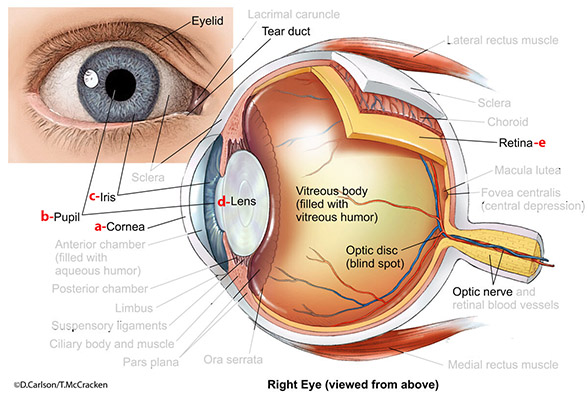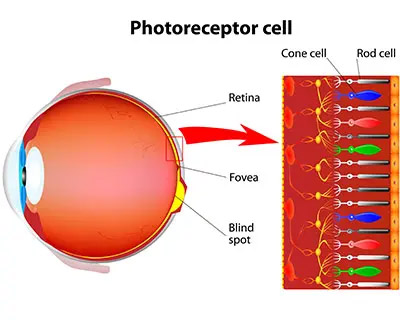It is funny to realise what is happening at this very moment with light entering your eye.
Call me an eye-fan, a seeing fanatic or a visual geek, I don't care as long as you promise me one thing: Will you please, please, please be careful with your eyes? Just imagine to be alive when you can't see.
So wear protection when you are working with machines, sunglasses in too bright light and goggles in the swimming-pool.
And stay away from fire-works, teargas and drugs. But you already knew that, didn't you?
Workplace eye injury statistics 8 Apr 2021 - .. Of these 300,000 eye injuries, it's estimated that 90% of them were preventable if the workers had been wearing the appropriate eye protection ..


The eye: Our eyes are specialized organs that detect light and convert it into electrical signals that can be interpreted by the brain. The eye has several parts:
a. Cornea: The transparent outer covering of the eye that helps focus light.
b. Pupil: The black circular opening in the center of the eye that regulates the amount of light entering the eye.
c. Iris: The colored part of the eye surrounding the pupil. It controls the size of the pupil and thus the amount of light that enters the eye.
d. Lens: Located behind the iris, the lens further focuses the incoming light onto the retina.
e. Retina: The inner lining at the back of the eye that contains specialized cells called photoreceptors. These photoreceptors are of two types:
- Rods: They are responsible for vision in low-light conditions and help us see black and white.
- Cones: They work best in bright light conditions and are responsible for color vision.
- Photoreceptor activation: When light reaches the retina, it activates the photoreceptor cells (rods and cones) in the area where it falls.
- Electrical signals: The activated photoreceptors convert the light into electrical signals.
- Signal transmission: The electrical signals are then transmitted from the retina through the optic nerve, a bundle of nerve fibers, to the brain.
How can we see?
Vision is the process by which organisms perceive the surrounding environment using the sense of sight. It involves the complex interplay between our eyes, the brain, and the visual system. Here is a simplified explanation of how we see:
- Light enters the eye: Visual perception begins when light enters the eye through the cornea, the transparent outer covering of the eye. The cornea helps to focus the light.
- Light passes through the pupil: The light then passes through the pupil, the black circular opening in the center of the colored part of the eye called the iris. The iris adjusts the size of the pupil to regulate the amount of light entering the eye.
- Light is focused by the lens: Behind the pupil, there is a lens that further focuses the incoming light onto the retina at the back of the eye. The lens adjusts its shape to ensure the light converges onto the retina correctly.
- Image formation on the retina: The retina is a layer of light-sensitive cells located at the back of the eye. It contains specialized cells called photoreceptors, specifically rods and cones. Rods are responsible for vision in low light conditions, while cones are responsible for color vision and visual acuity. The incoming light stimulates these photoreceptor cells.
- Signal transmission: When light hits the photoreceptor cells, it triggers a chemical reaction that generates electrical signals. These signals are then transmitted through the optic nerve, a bundle of nerve fibers that connects the retina to the brain.
- Visual processing in the brain: The optic nerve carries the electrical signals to the brain, specifically to an area at the back of the brain called the visual cortex. The visual cortex processes the signals and interprets them to form the perception of visual images, including color, shape, motion and depth.
- Perception and interpretation: The processed visual information is integrated with other sensory inputs and stored knowledge in the brain. This allows us to recognize objects, navigate our surroundings, and make sense of the visual world.
This explanation is a simplified overview of the complex process of vision. The human visual system is incredibly intricate and involves numerous neural pathways, specialized cells, and sophisticated processing mechanisms to create our perception of the visual world.
